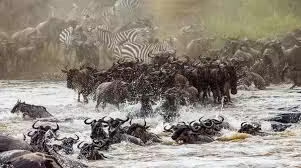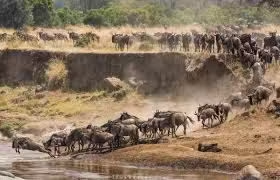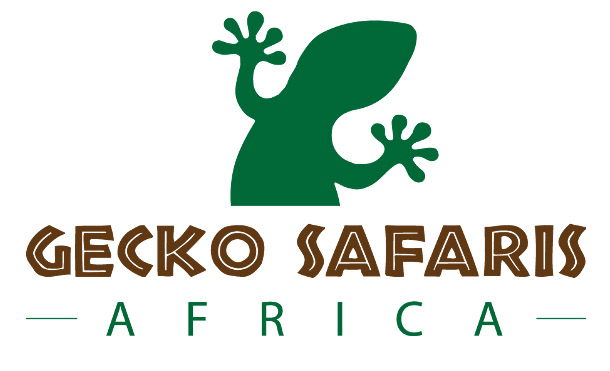A Premier Safari Destination in Serengeti National park.
A premier Safari destination, in Serengeti National Park extends to over 14,763 sq. km and is Tanzania’s largest park and a world-renowned safari destination known for its stunning landscapes and incredible wildlife.
The park’s name comes from the Maasai word “siringet,” meaning “endless plains.” Located in northern Tanzania, it extends into southern Kenya connecting with the Maasai Mara Reserve.
Wildlife and Annual Migration


Serengeti is famous for the Great Migration, an awe-inspiring natural event where millions of wildebeests, zebras, and gazelles migrate between the Serengeti and Maasai Mara, crossing the Grumeti and Mara rivers.
This spectacle, accompanied by predators such as lions, leopards, cheetahs, and hyenas, draws visitors worldwide.
Serengeti is home to over 3 million large mammals, including elephants, buffalo, giraffes, rhinos, and hippos as well as 500 bird species like flamingos, eagles and ostriches.
Attractions in Serengeti National Park
The Great Migration

The Great Migration is one of the most remarkable wildlife spectacles in the world, where over 1.5 million wildebeests alongside hundreds of thousands of zebras and gazelles migrate in search of fresh grazing.
This event occurs annually, typically between May and June and involves a treacherous crossing of the Grumeti and Mara rivers.
Visitors can witness massive herds, dramatic river crossings, and intense predator-prey interactions, providing an unforgettable experience.
Moru Kopjes

Moru Kopjes are granite rock formations that rise out of the plains, creating an oasis of shade and water, attracting wildlife, including predators like lions and leopards.
This area is also a critical habitat for the endangered black rhino.
Moru Kopjes are known for their ancient Maasai rock paintings and Gong rocks, which were once used as musical instruments by the Maasai people.
Seronera River Valley
The Seronera Valley, located in the central part of the park, is renowned for its year-round water supply, making it a hotspot for diverse wildlife, including the elusive leopard, large lion prides, elephants, and cheetahs.
The lush, verdant landscapes, intersected by rivers and dotted with acacia trees offer a perfect backdrop for game viewing.
Grumeti River
This river is famous for its crocodile population, which poses a significant threat to migrating wildebeests and zebras.
The Grumeti River crossing is highlights of the Great Migration where visitors can watch dramatic scenes unfold as animals brave the waters teeming with crocodiles and hippos.
The riverbanks are also home to a variety of birds and other wildlife.
Retina Hippo Pool
Located near the Seronera Valley, the Retina Hippo Pool is an ideal spot to see large pods of hippos wallowing and playing in the water.
Visitors can observe these massive creatures up close from safe viewing points.
The pool is also a popular spot for crocodiles, adding an extra thrill to the visit.
Olduvai Gorge
Situated on the park’s southeastern border, Olduvai Gorge is one of the most important pale anthropological sites in the world.
Discovered by Dr. Louis Leakey and his team, this site has produced some of the earliest evidence of human ancestors, dating back nearly 2 million years.
A museum and guided tours are available, offering insights into the history of early human evolution.
Maasai Culture and Villages
The Maasai people have inhabited the Serengeti region for centuries. Visiting a Maasai village offers a unique cultural experience, allowing visitors to learn about Maasai customs, traditions, and daily life.
Guests can engage in activities like traditional dance performances, witnessing craft-making, and visiting local markets.
Activities to Do in Serengeti National Park
Game Drives
Game drives are the most popular way to explore the park, typically conducted early in the morning and late in the afternoon when wildlife is most active.
These guided tours provide an opportunity to spot the “Big Five” (lion, leopard, elephant, buffalo, and rhinoceros) and many other species, including giraffes, cheetahs, zebras, and hippos.
Hot Air Balloon Safaris

A hot air balloon safari offers a bird’s-eye view of the Serengeti at dawn.
This serene adventure provides a unique perspective of the park’s landscapes, rivers, and wildlife, including the Great Migration herds.
The flight concludes with a traditional champagne breakfast in the bush, making it a memorable experience.
Walking Safaris
Walking safaris are an exciting way to explore the Serengeti on foot, accompanied by armed guides and rangers.
This immersive experience allows visitors to get up close with the park’s flora and smaller fauna, learn about tracking animals, and gain a deeper understanding of the ecosystem.
Walking safaris offer a unique way to appreciate the park’s biodiversity and subtle beauty.
Bird Watching Tours
With over 500 bird species, Serengeti is a paradise for birdwatchers. Enthusiasts can spot a variety of birds, such as vultures, eagles, flamingos, storks, and the rare Fischer’s lovebird.
Specialized bird-watching tours are available, focusing on the best locations and times to see both resident and migratory bird species.
Cultural Tours and Visits to Maasai Villages
Cultural tours provide a deep dive into the traditions and daily life of the Maasai people. Visitors can participate in a range of activities, from watching traditional dances and listening to stories to learning about Maasai beadwork and visiting their homesteads.
These tours are an excellent opportunity for cultural exchange and gaining a deeper understanding of local customs.
Visit to Olduvai Gorge

A trip to Olduvai Gorge is a must for history enthusiasts, offering guided tours and museum visits that explain the significance of the archaeological discoveries made here.
It provides a unique perspective on early human history, with displays of fossils and artifacts dating back millions of years.
Photography Safaris
Serengeti is a photographer’s dream, with endless opportunities to capture stunning landscapes, dramatic wildlife moments, and vibrant sunrises and sunsets.
Specialized photography tours are available with guides who understand the best times and locations for capturing the perfect shot.
Night Game Drives

Some areas of Serengeti offer night game drives, which provide a different perspective on the park’s wildlife.
Under the cover of darkness, visitors can spot nocturnal animals such as aardvarks, civets, porcupines, and predators on the hunt.
Best Time to Visit Serengeti National Park
Great Migration: June to October.
Witness dramatic river crossings at the Grumeti and Mara Rivers, with wildebeests, zebras, and gazelles moving between Serengeti and Maasai Mara.
General Game Viewing: December to March.
Enjoy easy wildlife spotting around waterholes and see newborn animals during the calving season in the southern Serengeti.
Bird Watching and Lush Scenery: November to April.
Ideal for birdwatchers with lush landscapes and migratory birds, though spotting wildlife can be harder due to dense vegetation.
Avoiding Crowds: April to May.
Experience fewer tourists and lower prices during the long rains, with lush scenery and dramatic skies.
How to Reach Serengeti National Park
By Air:
International Flight to Kilimanjaro International Airport (JRO): Fly into Kilimanjaro International Airport, located about 29 miles from Arusha. From there, take a domestic flight on a chartered plane to one of the Serengeti airstrips, such as Seronera, Lobo, or Kogatende.
Domestic Flights: Alternatively, you can take a direct flight from major Tanzanian cities like Arusha or Dar es Salaam to Serengeti airstrips.
By Road:
From Arusha: The drive from Arusha to Serengeti National Park typically takes about 8 hours. The route involves a journey through scenic landscapes, including the Ngorongoro Conservation Area. Road travel is often done in a 4×4 vehicle, as the roads can be rough, especially during the rainy season.
By Private or Scheduled Transfer:
Private Transfers: Arrange a private transfer or guided tour with a safari company that includes transportation to the park. This can offer more flexibility and comfort compared to self-drive options.
Scheduled Transfers: Some safari operators provide scheduled transfers from Arusha or other nearby locations directly to Serengeti.

